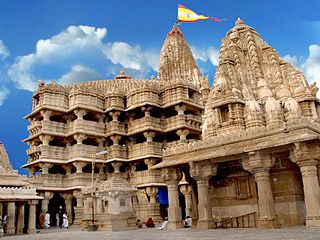
Dwarka is a town and municipality of Devbhumi Dwarka district in the state of Gujarat. It is located on the western shore of the Okhamandal Peninsula on the right bank of the Gomti river at the mouth of the Gulf of Kutch facing the Arabian Sea. The name “bet” comes from Arabic, meaning “home”.
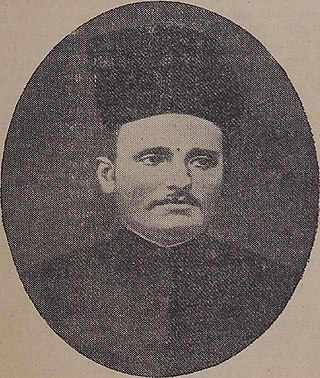
Karsandas Mulji was a journalist, social reformer and administrator.
Usmānpurā is a suburb of Ahmedabad. The village of Usmānpurā was founded by Sufi saint Saiyad Usman, who was a disciple and successor of Qutub-ul Ālam. The suburb is the site of the Gujarat Vidyapith, founded by Mahatma Gandhi.

Nagar Brahmin is a Brahmin subcaste from the Indian state of Gujarat.
Avarna communities are those that do not belong to one of the four varnas.
Bania is a mercantile caste mainly from the Indian states of Gujarat and Rajasthan, with strong diasporic communities in Uttar Pradesh, Madhya Pradesh, West Bengal, Maharashtra and other northern states. Traditionally, the main occupations of the community are merchants, bankers, money-lenders, and owners of commercial enterprises.
Shah e Alam, born on 17 Dhul Qidah 817 Hijri/18 January 1415 AD at Patan city in Gujarat, India, is a Muslim religious teacher and great Wali residing in Ahmedabad, Gujarat, India during the Dehli sultanant.
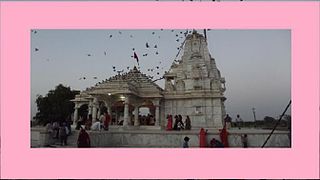
The Sachora Brahmin are a Brahmin communitiy found in Gujarat. They originate from Sanchore in Rajasthan.

Mahagujarat movement, known locally as Mahagujarat Andolan, was a political movement demanding the creation of the state of Gujarat for Gujarati-speaking people from the bilingual Bombay state of India in 1956. It succeeded in the formation of Gujarat on 1 May 1960.
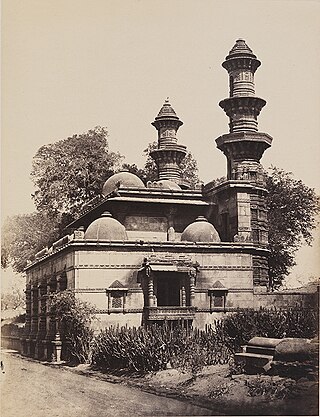
The Muhafiz Khan Mosque is a fifteenth-century mosque located in the city of Ahmedabad in the Indian state of Gujarat. It is considered to be one of the more exceptional structures in the city. The mosque was constructed in 1465 by Jamail-ud-Din Muhafiz Khan during the reign of Mahmud Shah I (1458-1511), and is considered to be an excellent example of Mughal architecture. It is named for the governor of the region at that time. The mosque is a protected building under the auspices of the Archaeological Survey of India.

Anandghan was a 17th-century Jain monk, mystical poet and hymnist. Though very little is known about his life, his collection of hymns about philosophy, devotion and spirituality in vernacular languages are popular and still sung in Jain temples.
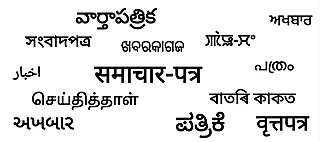
The Media in Gujarati language started with publication of Bombay Samachar in 1822. Initially the newspapers published business news and they were owned by Parsi people based in Bombay. Later Gujarati newspapers started published from other parts of Gujarat. Several periodicals devoted to social reforms were published in the second half of the 19th century. After arrival of Mahatma Gandhi, the Indian independence movement peaked and it resulted in proliferation of Gujarati media. Following independence, the media was chiefly focused on political news. After bifurcation of Bombay state, the area of service changed. Later there was an increase in readership due to growth of literacy and the media houses expanded its readership by publishing more editions. Later these media houses ventured into digital media also. The radio and television media expanded after 1990.

Baba Lului's Mosque, also known as Baba Lavlavie's Masjid, is a medieval mosque and tomb complex in Behrampura area of Ahmedabad, India.
Indumati Chimanlal Sheth was an Indian independence activist, politician, social worker and educationist from Gujarat. Born in Ahmedabad and influenced by Mahatma Gandhi, she participated in the independence movement and later served as a deputy education minister of the Bombay State and education minister of Gujarat. She was awarded the Padma Shri in 1970 for her social work.
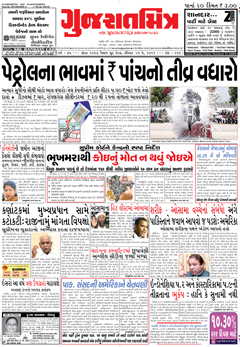
Guajratmitra is a leading daily newspaper of Surat and Gujarat in India. It is published from Surat, in Gujarati. It was founded in 1863 and is one of the oldest newspapers of India.
Satyaprakash was a Gujarati language weekly founded by social reformer and journalist Karsandas Mulji with an intention of social reform. Launched in 1855, it ran until 1861 and later was merged with Rast Goftar, another newspaper published in Bombay.

The Ahmedabad Town Hall, officially Sheth Mangaldas Girdhardas Memorial Hall, is an auditorium in Ahmedabad, India. It is named after Mangaldas Girdhardas, a textile industrialist.
Hariprasad Vrajrai Desai was an Indian independence activist, social worker and Gandhian from Gujarat, India. He was honored with the first Kumar Suvarna Chandrak (1944).
Achyut Yagnik was an Indian journalist, academic, political analyst and activist based in Ahmedabad, Gujarat.










